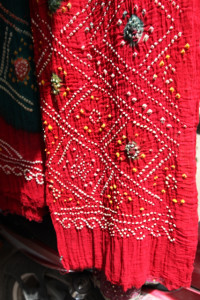A controlled tie-dye technique particular to the Khatri community in Kutch and in communities in and around Jodphur, India for day-to-day scarves, marriage shawls and saris. Bandhani is also just as beautifully and skilfully executed in silks, cotton muslins, heavier homespun cottons as in wool.
The technique involves transferring a pattern of small dots onto fabric and tightly binding each with thread to create a tiny area, or spot, that can’t be penetrated by the dye. Once all the dots have been tied, the fabric is dipped into dye baths in one or more tsone or colours. After the fabric has dried, the threads are cut and the fabric opened out to reveal the pretty result.
It’s easy to buy lovely bandhani silk scarves and pack them into your suitcase to wear later, although they may perhaps be better enjoyed everyday as trimmings, cushions, bolsters, window seats and very lovely lampshades.
Silk bandhani pieces for head wraps and scarves,
A collaborative project, initiated after the 2001 earthquake by Christina Kim of the company Dosa, the Kutch people and the National Institute of Design in Ahmedabad, India, has taken the craft beyond the traditional designs, producing exciting innovations with the cloth, the technique, the colours and the expected patterns.


